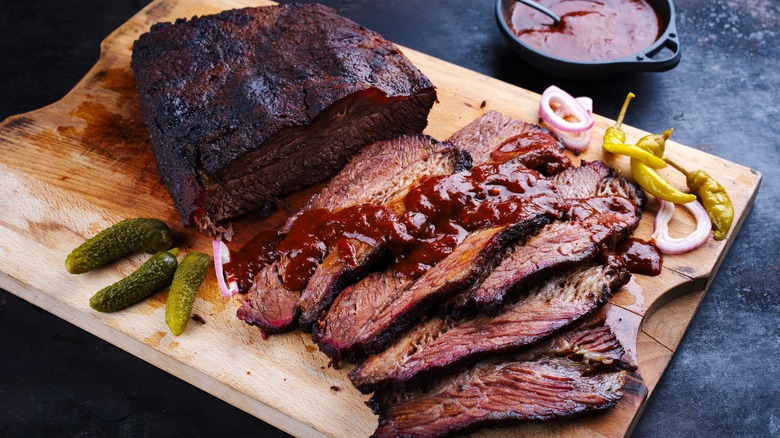How To Choose The Absolute Best Brisket With The Bend Test
Buying a piece of brisket can always be a gamble. While it doesn't have the same stakes as a tense game of poker, you may still find yourself holding your breath, wondering what its consistency will be like when you slice into it. The main factor that dictates whether your meat will be tender or tough boils down to the cut, and brisket is a notoriously stiff piece of meat. Although you can't tell from looking at the brisket whether it'll be perfectly tender, the bend test may help you determine its outcome.
Bend the brisket in half so the ends are touching each other — if they easily reach one another, the brisket will most likely be tender. If not, this may indicate that the beef is filled with hard fat. Fat is rarely a bad thing for beef to have, but hard fat in brisket won't melt away, making an already tough piece of meat even tougher. A failed bend test could also mean the brisket is filled with connective tissues. Brisket is rife with dense and hardened collagen. While connective tissues aren't exactly inflexible, they do resist bending, making for a firm brisket that won't be enjoyable to eat.
What should you look for in a brisket?
If you want to choose the perfect brisket, you'll need to look for one that's aged, as these are generally more tender. During the process, enzymes break down the tough connective tissues while also concentrating the flavor of the meat, making it taste richer. Although this process will wear down the collagen, the finished product will also wear down your wallet. Since dry-aged beef is expensive, we don't blame you for going for a cheaper piece of brisket — just be sure to give it that bend test first.
Collagen tends to break down when cooked long and slow, but, unfortunately, the collagen in brisket tends to bind together, so it won't all break down. That said, you can always utilize tallow when smoking brisket for the juiciest meat. The hard fat on brisket, though, doesn't render down at all and will need to be removed. On the brisket you'll see white masses of fat that can be trimmed away either by you or a butcher. When shopping for brisket, aim for one that has as little of this fat as possible. The fat that dots the outer surface is easy to remove, but there's a layer that's right in the middle of the brisket that will need to be cut away after the meat is cooked.

